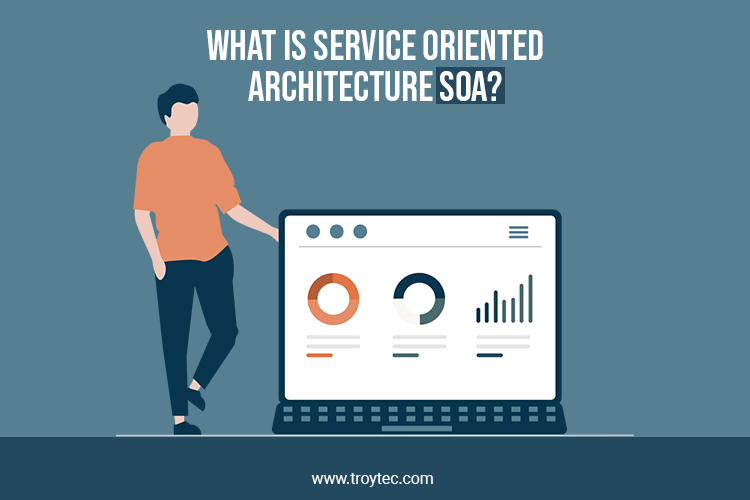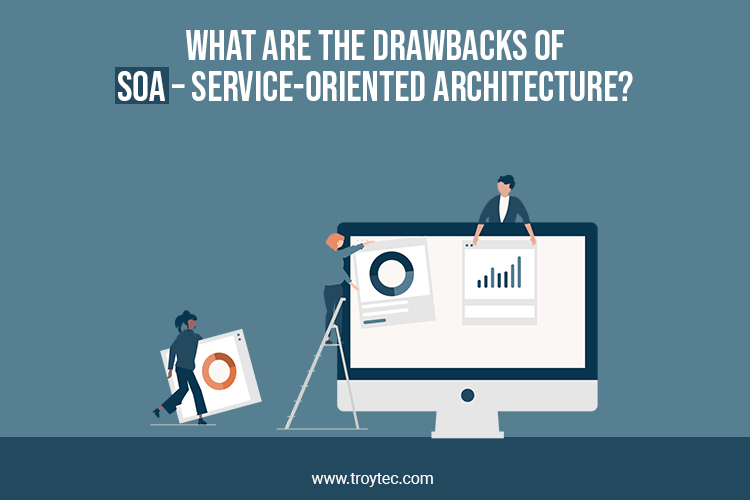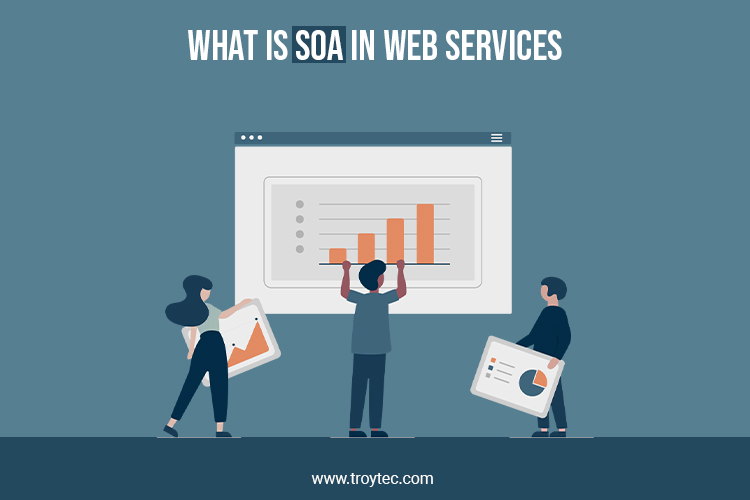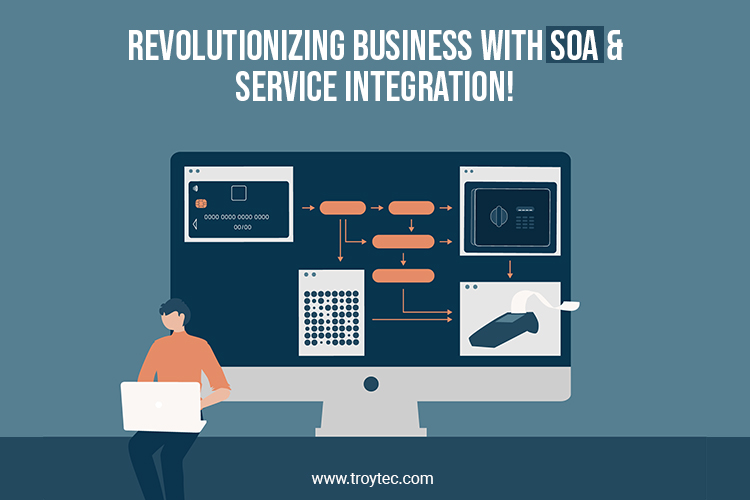Introduction
Each service is a separate component of the broader application that should fulfill a defined purpose, such as taking something in and converting it into a helpful output. As a result, SOA & Service is fundamentally task-specific, with particular services for activities such as receiving a payment, obtaining an item such as an order assertion, or managing an established account.
It’s a highly scalable and versatile method of building applications by including additional features in a modular fashion, and it can also assist in breaking the building process into more manageable parts that can be allocated to specific people and small teams.
SOA has aided in this rise in cooperation by allowing huge development groups to collaborate without damaging overlap between tasks allocated to them while contributing to a single fundamental application.
However, when the total application size grows, it might become more diligent to avoid intricacy, and providing an update can take longer because the complete program code must be changed at once. This is where microservices come in, by breaking down large amounts of code into small, agile operations that can be deployed independently.
A platform like Kong may then construct data routes, basically building a chain of these inputs and outputs containers that receive the supplied parameters and transform them on multiple occasions to achieve a single purpose.
Keep or continue reading and exploring the blog to learn how SOA & Service can significantly impact today’s world.
What is Service Oriented Architecture SOA?

SOA is a way to develop software that allows reusable services to be communicated across various platforms and languages to construct new applications. An SOA service is a self-sufficient piece of software that performs a specified activity. To create new apps, applications leverage SOA & Service interface specifications to access services.
SOA or Service-oriented Architecture enables app and service integration. It ensures that existing applications may be quickly scaled while lowering costs associated with creating company-wide solutions.
Organizations also use SOA to design applications that require numerous systems to interact with one another efficiently. The following are the fundamental concepts of SOA:
- Technical strategy is less significant than business value.
- Strategic objectives are more potent than project-specific advantages.
- Custom incorporation is less important than essential interoperability.
- Shared services will be more powerful than purpose-specific solutions.
- Constant enhancement is more vital than perfectionism.
Service-oriented architecture – SOA is a software development strategy that uses software components called services to create business apps. Each service offers a business capacity, and services can communicate across technologies and languages. Developers employ SOA & service to recycle services across organizations or to integrate numerous independent services to complete complex tasks.
For example, numerous company procedures in an organization necessitate user authentication. Instead of rewriting an authentication code for each business activity, you may establish one authentication system and reuse it across all applications. Similarly, practically all systems in the healthcare business, such as client management systems and EHR systems (electronic health records), require patient registration. These systems can use a single, shared service to fulfill the patient authentication task.
How Does SOA Work?
SOA divides complicated software systems into reusable amenities used by other programs and users known as service consumers. These SOS services can serve as the foundation for future applications. Each SOA & service has a unique task that includes an interface that specifies the service’s inputs and outputs and the communication method required to reach it.
SOA empowers services to communicate or interact with one another via a loose coupling framework to transmit data or manage an action. Loose coupling occurs when a service client remains irrespective of the service it demands. Furthermore, the client (a service) can communicate with other services, even if they are unrelated.
A consumer or program owner submits input data to a service to request knowledge or a task. The service processes the information, completes the requested action, and returns a response.
For example, a sales or marketing representative could make an SOA & service request from a consumer relationship management framework, which offers access to customer data. The employee can provide relevant information to the service, such as a particular customer’s name, and the provider will provide the requested reaction, which may include the consumer’s purchase history.
SOA is a computational service idea or service model implementation. Business processes and operations are executed as software services in this organizational approach, accessed via a set of carefully specified software interfaces known as application programming interfaces (APIs), and integrated into applications via dynamic service orchestration.
What are the Benefits of SOA – Service-Oriented Architecture?
The advantages of service-oriented architecture – SOA) over traditional monolithic systems in which every operation runs as a single unit are numerous. The following are some of the most significant advantages of SOA:
- Quicker time to market: To save time and money, developers recycle services across several business processes. They may assemble applications more quickly with SOA than they could by developing code and executing integrations from scratch.
- Efficient maintenance: Small services are more accessible to design, update, and debug than huge code blocks in monolithic programs. In SOA & service, changing any service does not affect the general usability of the business process.
- Increased adaptability: SOA is more adaptive to technological developments. You may upgrade your apps efficiently and cost-effectively. Healthcare firms, for example, can incorporate functionality from previous electronic medical records into newer cloud-based apps.
- Reusability of services: SOA builds applications from current services. As a result, services can be leveraged to create various applications.
- Simple maintenance: Because services are detached, they may be readily updated and adjusted without disrupting other services.
- Platform independence: SOA enables the creation of complex applications by mixing services gathered from various sources, regardless of platform.
- Availability: SOA capabilities are easily accessible to anyone who requests them. SOA & Service programs are more dependable because tiny services are easier to debug than large codes.
- Scalability: Applications can run on separate servers within an environment, increasing scalability.
What are the Drawbacks of SOA – Service-Oriented Architecture?

- High above the ground: When services interact, their input parameters are validated, which reduces performance by increasing load and response time.
- High initial investment: SOA & service necessitates a significant initial investment.
- Complex service administration: When services interact, they communicate messages to tasks. The number of texts might be in the millions. Handling a considerable quantity of communications becomes difficult.
What are the Components of SOA?
SOA & service typically consists of four major components:
- Service. This is the basis of SOA & Service. Services might be private and only accessible to approved users or open-source and accessible to the public. Each SOA & Service includes a service deployment, which is the code that performs the service; the service contract, which describes the specifications of a service as well as its cost and excellence; and a service user experience, which is the top layer of a service that establishes how it interfaces with it and handles interactions with additional services and systems. Here are the more components of service:
- Implementation of services: The service execution is the code that creates the logic for accomplishing a particular service function, such as identity verification or bill computation.
- Service agreement: The service contract specifies the type of the service and its associated rules and regulations, such as the requirements for using the product or service, performance cost, and service quality.
- Interaction with a service: Other services or technologies communicate with a service via its service interface under SOA. The interface specifies how to use the service to execute tasks or exchange data. It lowers reliance on resources and the service’s requester. For example, users with little or no comprehension of the underlying coding logic can use an application through its interface.
- Provider of services. This component generates or provides the service in question. Most businesses either develop their services or rely on third-party services.
- Customer of a service. The SOA & Service user is the person, system, application, or additional service that requests assistance from the service provider. The service contract specifies the terms under which a service provider and a requester engage.
- Registry of services. A service registry, sometimes known as a service storage facility, lists available services. It is in charge of keeping service descriptions and other pertinent information on utilizing the provider’s services.
What is SOA in Web Services?

SOA and web services are not synonymous, and they are not indistinguishable. SOA is a software development method that leverages programming opportunities in individual, independent, yet loosely connected services. Web-based services are a standardized method of making those imagined services a reality by requesting and receiving data using web protocols such as HTTP.
Web services’ between machines interoperability is appropriate for collaborative networks or those that must offer public access via various distinctive devices, platforms, and operational systems due to its use of SOA & service common standards.
Web services can be created on any number of various technologies, and amenities built on separate platforms can still communicate with one another, making growth, development, and complexity far more manageable.
It enables gradual migration to new technological developments, such as transitioning away from SOAP and toward RESTful applications, which we’ll discuss in more depth later, without having to completely replace existing modules immediately. Uniform Source Identifiers, or URIs, are a more general variation on Uniform Resource Locators, or URLs, that can be utilized to access web services.
The URI can include the input parameters, often supplied after an inverted question mark, making it relatively simple to implement a method for end-users to provide input to a web service.
It has become a commonplace, universal means of accessing online amenities for regular internet connection and network users in general, so whatever your services attempt to achieve, contact with the end user can be consistent. Web services, microservices, and APIs are all methods for interacting with end users retrieving and processing data to achieve a goal.
In theory, the API is the interface itself, whereas microservices or web service framework in SOA & service also comprises computer code bits that are not visible to consumers.
A microservice delivered online can be the best service SOA; microservices installed locally may not be web services, but the names are sometimes used interchangeably. Much of the terminology employed, like microservices one another, is connected yet separate and only loosely coupled, and alludes to multiple levels of software design:
- SOA concerns the overall strategy, granularity, and deployment of each person’s reusable services.
- Web services and microservices deconstruct monolithic enterprise systems into containers that may be deployed more flexibly online or locally.
- APIs are the user interfaces that appear at the terminals of these services.
- SOAP, REST, and other similar concepts refer to the technology used for service connectivity.
- Furthermore, the various programming languages used to construct the code for each service underpin all of this.
It’s an ordinary many-layered onion, from broad concepts to granular micro-services development, and it visualizes well into complicated enterprise worker hierarchies with individuals working within departments and groups up to the whole company level. You might think of SOA & service as an idea and internet services as its manifestation; nevertheless, it’s crucial to realize that not all SOA & service takes benefit of web service compatibility or microservice precision, as we’ll see shortly.
SOA Vs. Web Services
Web services are used to create programs that can send and receive messages via HTTP using SOAP. A web service is an advertised functionality package accessible via the internet. SOA & service is a set of design principles for service creation and integration. SOA implementation can take advantage of web services. However, it is merely one approach to implementing SOA-based applications.
There are particular significant distinctions between Web services and SOA. Web services are a type of web technology that may be used to create applications that can exchange messages via SOPA over HTTP. SOA, on the other hand, is an architectural approach for developing loosely coupled service-based applications. SOA & service applications can be implemented via web services.
Even though the web service method of SOA has gained popularity, it is only one method for implementing SOA & Service. SOA can be deployed with any other service-oriented technology (for example, CORBA and REST).
SOA Vs. Microservices
The tenets and advantages of SOA and microservices appear identical, and the two actually possess aspects of the same general fingerprint. Microservices, like SOA & service, enable individual, distinct services to communicate with others via a platform such as the Kong API gateway; you’ll frequently hear the term loose coupling applied to both.
However, SOA & service is an umbrella word encompassing not only the architecture of microservices but also, more typically, somewhat monolithic, large-scale business applications. These often have a single app layer with several dependent Enterprise Services Bus, or ESBs, and cannot provide the flexibility, responsiveness, and complexity that microservices can.
As a result, it’s critical to recognize that, while microservices are a type of SOA, not each SOA & service provides the vast and practical benefits that microservices do.
In truth, traditional SOA & service do not provide that flexibility; compared to intrinsically modular microservices, traditional SOA merges multiple services into an individual application. As a result, the app may become complex, heavyweight, and more susceptible to operational difficulties and other dangers caused by various distinct processes, all of which can slow it down.
Consider the adaptability of microservices architectures. In contrast to traditional SOA’s monolithic approach, Microservices are modular, employing distinct strings of software code to do unique, specific tasks.
By keeping microservices miniature and independent of each other, you can work on them independently, making it much easier to break down massive business applications into more minor services, across which various development groups and individuals can communicate more readily.
Each microservice can be executed and updated without bringing the entire application down, and an infrastructure like the Kong API portal enables them to communicate with one another despite differences in programming syntax and other commonly essential features that they do not share.
It enables service-client and service-service interpersonal interaction, allowing you to design routes that define multiple data channels and change that data one or more times to convert the initial input into a specified usable output in the appropriate format.
Microservices are a natural next step in SOA growth. Whereas service-orientated architecture separates large monolithic enterprise applications into independent services, microservices take this a step further for more flexibility.
The result is a system that extends the benefits of SOA & service to another dimension, making it easier to design new microservices, distribute them with low to zero downtime, scale by adding more instances with minimal disruptions, and upkeep them in the future.
This strategy provides good redundancy and upgrades microservices with updated versions when your programmers complete them. If a bug is detected in one section of an application, for example, it is considerably simpler to replace that part rapidly without causing downtime across entire critically essential enterprise systems.
Microservices distinguish themselves from the traditional concept of monolithic SOA by improving productivity, lowering programming and upkeep costs, and increasing business resiliency.
SOA Vs. SaaS
Software-as-a-service (SaaS) is a type of public cloud computing in which an operator or public cloud provider provides a complete business app from the cloud using a RESTful API.
SaaS is another developing cloud that has impacted SOA and, in some respects, returns to the original SOA fundamentals. Because the purpose is to provide comprehensive support for a company process in the cloud, SaaS is more correctly referred to as application as a service. Because the service is an industry process, SaaS is similar to SOA & service. SaaS is also identical to some microservices in that it is provided in line with a service agreement specifying service levels and pricing.
SaaS services will almost always provide APIs to facilitate the integration of SaaS interaction with additional company procedures that continue to run in the data center or another cloud location. These interfaces, however, will adhere to contemporary microservice and API principles rather than SOA and web services principles.
Conclusion
With the introduction of web services and SOA, there is the possibility for cheaper integration costs and better flexibility. The division of the service surface (the what) from how it’s done (the how) is a fundamental feature of SOA& service. Clients using such services are unconcerned about how the providers will fulfill their desires. Web services are the next peer group of the Web since they promise the facilities and instruments for automating interactions between businesses over the internet.
JSR 208 (Java Business Connection) has the potential to alter the business by allowing platform suppliers, systems integrators, and commercial software developers to work on integrated solutions that are adaptable to changing market conditions.
Adopting Service-Oriented Architecture (SOA) represents a significant change in how businesses function and communicate. This innovative technique enables continuous communication and interaction across diverse components, allowing agility, scalability, and effectiveness.
SOA enables firms to react quickly to changing market needs by breaking down boundaries and increasing interoperability. It improves system responsiveness, resulting in better client experiences and increased competitiveness.
Furthermore, the modular design of SOA & service allows for faster maintenance and updates, lowering the overall cost associated with ownership over time. It also provides a platform for future technical improvements, ensuring long-term sustainability in a constantly changing corporate landscape.
The advantages go beyond the technological. SOA fosters a collaborative culture where diverse departments and systems collaborate to achieve common goals. Comment if you have any queries related to SOA & service, and you can provide valuable suggestions on how SOA can revolutionize modern business architecture.

